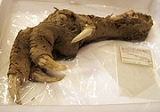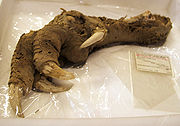
Lesser Megalapteryx
Encyclopedia
The Lesser Megalapteryx or Upland Moa
(Megalapteryx didinus) was a species of ratite
bird endemic to New Zealand
. Ratites are flightless birds with a sternum
without a keel. They also have a distinctive palate
. It was the last moa species
to become extinct, vanishing around 1500.
 Several specimens with soft tissue and feather remains are known:
Several specimens with soft tissue and feather remains are known:
only and in high-altitude beech
forests.
Moa
The moa were eleven species of flightless birds endemic to New Zealand. The two largest species, Dinornis robustus and Dinornis novaezelandiae, reached about in height with neck outstretched, and weighed about ....
(Megalapteryx didinus) was a species of ratite
Ratite
A ratite is any of a diverse group of large, flightless birds of Gondwanan origin, most of them now extinct. Unlike other flightless birds, the ratites have no keel on their sternum—hence the name from the Latin ratis...
bird endemic to New Zealand
New Zealand
New Zealand is an island country in the south-western Pacific Ocean comprising two main landmasses and numerous smaller islands. The country is situated some east of Australia across the Tasman Sea, and roughly south of the Pacific island nations of New Caledonia, Fiji, and Tonga...
. Ratites are flightless birds with a sternum
Sternum
The sternum or breastbone is a long flat bony plate shaped like a capital "T" located anteriorly to the heart in the center of the thorax...
without a keel. They also have a distinctive palate
Palate
The palate is the roof of the mouth in humans and other mammals. It separates the oral cavity from the nasal cavity. A similar structure is found in crocodilians, but, in most other tetrapods, the oral and nasal cavities are not truly separate. The palate is divided into two parts, the anterior...
. It was the last moa species
Species
In biology, a species is one of the basic units of biological classification and a taxonomic rank. A species is often defined as a group of organisms capable of interbreeding and producing fertile offspring. While in many cases this definition is adequate, more precise or differing measures are...
to become extinct, vanishing around 1500.
Fossils and remains

- British MuseumBritish MuseumThe British Museum is a museum of human history and culture in London. Its collections, which number more than seven million objects, are amongst the largest and most comprehensive in the world and originate from all continents, illustrating and documenting the story of human culture from its...
A16, found at QueenstownQueenstown, New ZealandQueenstown is a resort town in Otago in the south-west of New Zealand's South Island. It is built around an inlet called Queenstown Bay on Lake Wakatipu, a long thin Z-shaped lake formed by glacial processes, and has spectacular views of nearby mountains....
in 1876, is the type of the species. - Otago MuseumOtago museumThe Otago Museum is situated in Dunedin, New Zealand. It was founded in 1868 and has a collection of over two million artefacts and specimens from the fields of natural history and ethnography...
C.68.2A, leg with much muscle tissue, skin and feathers from the Old Man Range - Museum of New Zealand Te Papa TongarewaMuseum of New Zealand Te Papa TongarewaThe Museum of New Zealand Te Papa Tongarewa is the national museum and art gallery of New Zealand, located in Wellington. It is branded and commonly known as Te Papa and Our Place; "Te Papa Tongarewa" is broadly translatable as "the place of treasures of this land".The museum's principles...
NMNZ S.000400, a skeleton with tissue on neck and head from the CromwellCromwell, New ZealandCromwell is a town in Central Otago in the Otago region of New Zealand.It is situated between State Highway 6 and State Highway 8 leading to the Lindis Pass, 75 km northeast, and Alexandra, 33 km south. The road to Alexandra winds through the Cromwell Gorge...
area. - Museum of New Zealand Te Papa TongarewaMuseum of New Zealand Te Papa TongarewaThe Museum of New Zealand Te Papa Tongarewa is the national museum and art gallery of New Zealand, located in Wellington. It is branded and commonly known as Te Papa and Our Place; "Te Papa Tongarewa" is broadly translatable as "the place of treasures of this land".The museum's principles...
NMNZ S.023080, a foot with some muscle and sinews, found on 7 January 1987 at Mount OwenMount Owen, New ZealandMount Owen is in the Tasman district of the South Island of New Zealand. It stands at 1875 metres above sea level and is part of the Marino Mountains....
. This was dated to be about 3,300–3,400 years old. - Museum of New Zealand Te Papa TongarewaMuseum of New Zealand Te Papa TongarewaThe Museum of New Zealand Te Papa Tongarewa is the national museum and art gallery of New Zealand, located in Wellington. It is branded and commonly known as Te Papa and Our Place; "Te Papa Tongarewa" is broadly translatable as "the place of treasures of this land".The museum's principles...
NMNZ S.027950, feathers found in 1949 at Takahe Valley, Fiordland, New Zealand. - Canterbury Museum NZ 1725, Remains of one partial egg which have been found at the Rakaia RiverRakaia RiverThe Rakaia River is in the Canterbury Plains in New Zealand's South Island. The Rakaia River is one of the largest braided rivers in New Zealand...
in 1971 are tentatively attributed to this species. The radiocarbon dateRadiocarbon datingRadiocarbon dating is a radiometric dating method that uses the naturally occurring radioisotope carbon-14 to estimate the age of carbon-bearing materials up to about 58,000 to 62,000 years. Raw, i.e. uncalibrated, radiocarbon ages are usually reported in radiocarbon years "Before Present" ,...
of approximately AD 1300–1400 is in line with this. Unusually, the eggshell is dark olive green, but even if the egg is of M. didinus, the shell color may have varied between individual eggs. - Museum of New Zealand Te Papa TongarewaMuseum of New Zealand Te Papa TongarewaThe Museum of New Zealand Te Papa Tongarewa is the national museum and art gallery of New Zealand, located in Wellington. It is branded and commonly known as Te Papa and Our Place; "Te Papa Tongarewa" is broadly translatable as "the place of treasures of this land".The museum's principles...
NMNZ S.023700, complete skeleton found by Trevor Worthy in March 1987 at Honeycomb Hill Cave, Oparara Valley
Habitat and range
It has been ascertained that this moa resided on the South IslandSouth Island
The South Island is the larger of the two major islands of New Zealand, the other being the more populous North Island. It is bordered to the north by Cook Strait, to the west by the Tasman Sea, to the south and east by the Pacific Ocean...
only and in high-altitude beech
Beech
Beech is a genus of ten species of deciduous trees in the family Fagaceae, native to temperate Europe, Asia and North America.-Habit:...
forests.
External links
- Upland Moa. Megalapteryx didinus. by Paul Martinson. Artwork produced for the book Extinct Birds of New Zealand by Alan Tennyson, Te Papa Press, Wellington, 2006
- Articulated skeleton at the Museum of New Zealand Te Papa Tongarewa

